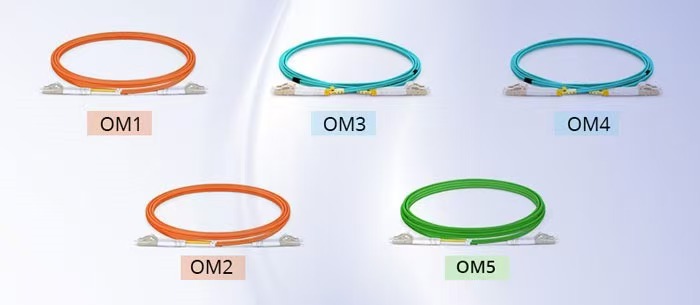Do you want to know the secret behind the high-speed data transmission across offices, data centres, and industrial networks? Well! Multimode fibres are the hidden heroes which play a vital role in ensuring seamless connectivity in different sectors. Moreover, fibre technology has been upgraded from OM1 to OM5 to meet the new evolving demands for bandwidth and speed, with each offering unique performance advantages.
That’s why the purpose of writing this blog is to make you aware of these multimode fibre types and their key differences. Thus, by selecting the appropriate type you can upgrade your old systems or prepare them for even 400G networks.

1) What is a Multimode fibre optic cable?
“A Multimode Fiber is a type of fibre cable that enables the transmission of multiple light signals ( LED or VSSEL ) within one core simultaneously.”
Unlike single-mode fibre ( ideal for long distances), multimode fibres can transmit light signals to short distances. The reason is that it has a larger core ( part of the cable which receives light ) having a diameter of about 50µm or 62.5µm. Thus, this large core allows multiple light signals to travel at the same time. However, there is also a challenge which they have to undergo. For instance, different light signals will arrive at different times, thus large signal distortion occurs over a large distance.
- Why Should You Use Multimode Fiber?
You can save a lot of money by utilising multimode fibres. This is because multimode fibres are compatible with cheap VCSEL and LED light sources. It is also easier to install as the fibre requires lower precision and alignment which minimizes the need for maintenance and complexity.
In addition, multimode fibres aid in short-distance data travel at high speeds as they support 10G, 40G, and 100G connections. If long-distance transmission is not required for internal networks, multimode fibres are the most cost-effective and powerful option.
2) Understanding the OM Fiber Classification
The OM (Optical Multimode) is basically a classification system for multimode fibres and is set by the ISO/IEC 11801 standard. Keep in mind that different OM types have different bandwidths, transmission distances, or data rates, making it easier for you to find the correct fibre for your needs.
Well! There are actually 5 types of multimode fibre cable: OM1, OM2, OM3, OM4, and OM5.
These different OM types were created due to the demand for networks with greater capacity to quickly transfer data over longer distances. You know the newest OM5 fibre can utilize short wavelengths, enabling multiple signals on one fibre to achieve greater data rates than previous generations.
Moreover, a Qoura user named Angelina Li has also well explained the difference between multimode fibre optic types on the basis of core size and bandwidth.
- OM1 vs. OM2 vs. OM3 vs. OM4 vs. OM5: What’s the difference
Let’s have a look at the differences between these OM types. But before proceeding further, I want to clarify one thing within these fibres, the most significant contrast lies in the extent to which they can support higher data rates over increasing distances, and this is determined by modal dispersion and the effectiveness of the light source used.
| Core size | Light source | Max Transmission distance | Key Uses | |||
| 1G | 10G | 40G/100G | ||||
| OM1 | 62.5µm | LED | 275m | 33m | Not supported | Legacy networks, small offices |
| OM2 | 50µm | LED | 550m | 82m | Not supported | Enterprise LANs, older fibre networks |
| OM3 | 50µm | VCSEL | 550m | 300m | 100m | Data centres, high-speed networking |
| OM4 | 50µm | VCSEL | 550m | 550m | 150m | Large-scale data centres, backbone networks |
| OM5 | 50µm | VCSEL + SWDM | 550m | 550m | 150m+ (supports SWDM) | Future-ready data centres, cloud computing |
i) OM1 Fibre optic cable
OM1 fibre has a core diameter of 62.5µm, which permits the propagation of a number of light modes, but also results in higher modal dispersion as discussed earlier. It is tailored for 850 nm LED light sources that have low coupling efficiency due to their broad spectral width.
Because of these limitations, OM1 is capable of supporting 1Gbps transmission rates at distances of 275 meters. With an outdated dispersion and lowered modal bandwidth (which determines how much data can be transmitted over a particular distance ), estimated to be around 200 MHz x kilometre at 850 nm, OM1 is not functional in modern high-speed networks.
However, OM1 can still be found in older Local Area Networks, smaller office environments, schools, and hospitals to support either 10 or 100 Megabits per second and 1 Gigabit per second Ethernet over short distances.
ii) OM2 Fibre optic cable
Compared to OM1, OM2 fiber has a 50µm core which allows for decreased signal distortion. Moreover, the signal integrity is also improved allowing for 1Gbps up to 550 meters. Although this is a step in the right direction, OM2 is still constrained by LED limitations and remains unable to efficiently support speeds beyond 10Gbps.
OM2 is a better version than OM1, so it is capable of supporting 1Gbps up to 550m and 10Gbps up to 82m, making it useful for enterprise networks, industrial automation, and educational facilities.
iii) OM3 Fibre optic cable
OM3 fibre has a 4x high modal bandwidth (2000 MHz·km at 850nm ) as compared to OM2 fibre cable. Thus, further increasing the optimal operating distance for VCSEL sources. Such characteristics allow OM3 to support 10 Gbps up to 300m, 40Gbps over 100 meters and 100Gbps over 70 meters.
That’s why, its tighter spectral width, higher coupling efficiency, and lower divergence compared to LED sources make OM3 ideal for use in data centres, enterprise networking, and cloud computing environments.
iv) OM4 Fibre optic cable
As a more developed type of OM3, OM4 fibre optic also has a 50µm core but has an effective modal bandwidth (EMB) of 4700 MHz.km at 850nm, which is higher than OM3. Moreover, it also allows 10Gp data transmission to distances over 550m and 40Gbps or even 100Gbps over 150m.
Thus, Limitless transmission distance without distortion of signals makes OM4 the most sought-after optical fibre for backbone networks, hyperscale data centres, and high-performance computing environments.
v) OM5 Fibre optic cable
OM5 is the most recent multimode fiber standard having a core diameter of 50µm. Unlike OM3 and OM4, which work on a single wavelength (850 nm), OM5 is capable of supporting multiple wavelengths ranging between 850 nm and 953. It enables four different channels to be transmitted simultaneously over a single fibre.
Thus, this advancement supports high-speed transmission of 100Gbps, 200Gbps, and 400Gbps over long distances. Moreover, it makes OM5 the ideal fibre for AI data central, ultra cloud computing and high-speed novel networking assists with AI tools.
- Physical Differences Between OM1, OM2, OM3, OM4, and OM5 (Jacket Color & Markings)
Moreover, one of the easiest ways to identify different multimode fibre types is by their jacket colour. The colour-coding standard helps technicians and network engineers quickly differentiate between fibre types during installation and maintenance.
| Jacket Color | Common Connector Types | |
| OM1 | Orange | SC, ST, LC |
| OM2 | Orange | SC, ST, LC |
| OM3 | Aqua (Teal) | SC, ST, LC, MPO |
| OM4 | Erika Violet or Aqua (Teal) | SC, LC, MPO |
| OM5 | Lime Green | SC, LC, MPO |
3) Conclusion
In short, by evaluating and comparing five major types of multimode fibre cable, it is evident that OM1 and OM2 are outdated but are still utilized in low-speed scenarios. However, if we talk about OM3 and OM4, then these facilitate high-speed data transfer fibres which are the industry norms. Moreover, OM5 is the latest fibre in the market supporting SWDM ( Short Wavelength Division Multiplexing) and 400Gbps applications.
Thus, selecting which multimode fibre to use relies on other parameters such as distance, bandwidth, and future expansion, assuring optimal performance in corporate networks, data hubs, and cloud computing systems.
Apart from this, a reliable manufacturer is equally important if you do not want to compromise the quality. So, I would suggest you to contact Dekam Fibres. We are China’s best fibre optic cable manufacturer and exporting our products to 35+ countries. So, don’t waste time and request an instant quote today!




